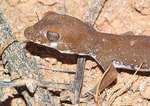Genetics help to spot the difference
 Environment Environment
University of Adelaide research has discovered that there are many more species of Australian lizards than previously thought. PhD student Paul Oliver, from the University's School of Earth and Environmental Sciences, has done a detailed genetic study of the Australian gecko genus Diplodactylus and found more than twice the recognised number of gecko species, from 13 species to 29. This study, done in collaboration with the South Australian Museum and Western Australian Museum, raises new questions about conservation and management of Australia's native reptiles. "Many of these species are externally very similar, leading to previous severe underestimation of true species diversity," said Mr Oliver. "One of the major problems for biodiversity conservation and management is that many species remain undocumented. "This problem is widely acknowledged to be dire among invertebrates and in developing countries. "But in this group of vertebrates in a developed nation, which we thought we knew reasonably well, we found more than half the species were unrecognised." Mr Oliver said this has great significance for conservation. For instance, what was thought to be a single very widespread species of gecko has turned out to be eight or nine separate species with much narrower, more restricted habitats and possibly much more vulnerable to environmental change, he said. "This completely changes how we look at conservation management of these species," he said. "Even at just the basic inventory level, this shows that there is a lot of work still to be done. Vertebrate taxonomy clearly remains far from complete with many species still to be discovered. This will require detailed genetic and morphological work, using integrated data from multiple sources. It will require considerable effort and expense but with potentially rich returns." A paper on this study was recently published online in Proceedings of the Royal Society B: Biological Sciences. The research was supported by grants from the Australia & Pacific Science Foundation and the Australian Biological Resources Study. Story by Robyn Mills
|






